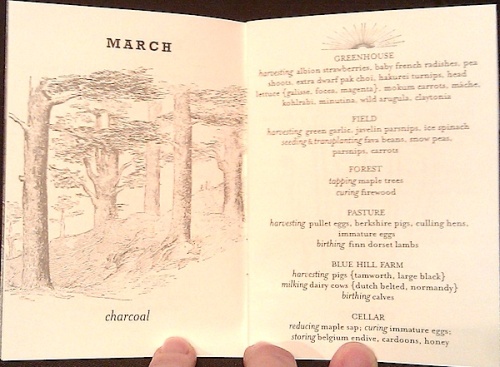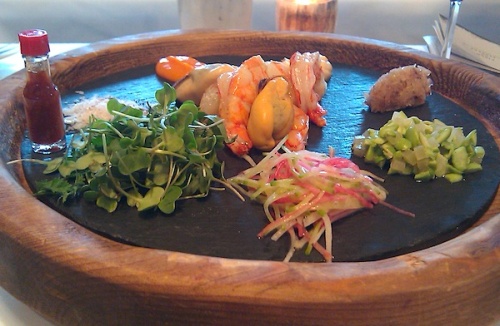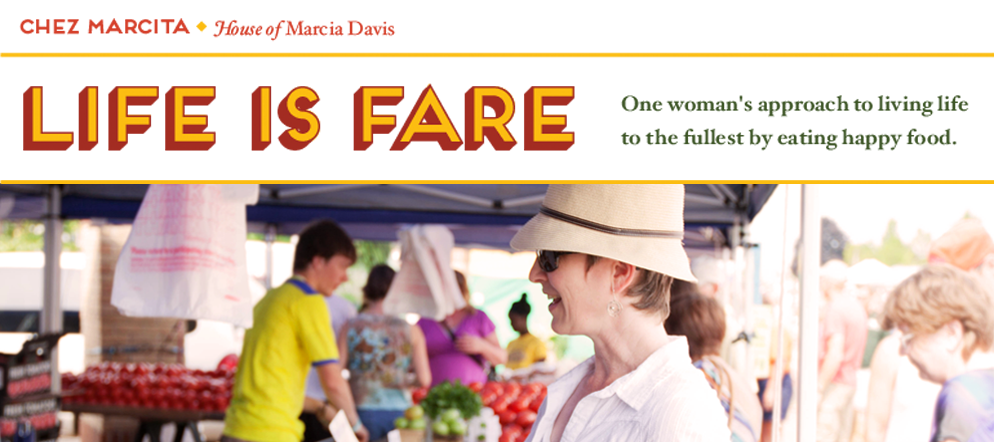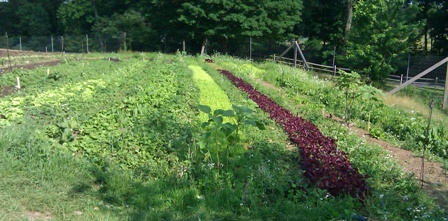One of my top-five favorite restaurants in the country is Blue Hill at Stone Barns, up the hill from Tarrytown, New York. For me living in Michigan it’s like a pilgrimage to go there because executive chef Dan Barber is more than a creative culinary artist. He’s an inspiration for home cooks and anyone who eats (that’s everyone!) by creating consciousness around everyday food choices. Three years ago I made the pilgrimage to Stone Barns with my friend and fellow home-chef, Cathy. When we visited this year, we brought Bill.
Arriving at our table we found a Field and Pasture Four Season Journal that lists the potential harvest by month. I loved reading the list and anticipating what we might be eating that night.


On the restaurant’s website there’s a phrase: Know Thy Farmer. Dan Barber’s philosophy is that great cooking starts with great ingredients. And great ingredients start with great farmers. You can find all the local farms that inspire the menus at both Stone Barns and Blue Hill New York (in Manhattan) by scrolling over a map on their webpage.
But I’d like to offer a new phrase that incorporates both restaurants’ philosophy: Know Thy Customer. The staff goes out of its way to accommodate people with food allergies, like Bill. At Stone Barns, where each meal is a “farmers’ feast” comprised of multi-course tastings from the day’s harvest, no meal is alike. It’s amazing to see how meals are customized for each person. It’s not just about food allergies; it’s about making your experience delightful by being attentive to your preferences–all within the confines of a seasonal harvest.
Here were our preferences for ingredients to avoid:
Bill: Wheat, corn, cow-dairy
Cathy: Mayonnaise
Marcia: Shellfish, mushrooms
We decided upon the 8-course feast, which means a variety of dishes keep coming out over a timespan of two to three hours.
The Vegetables on a Fence was the first to arrive, along with Pickled Asparagus and an egg-yolk dip (that I cannot remember the name of!). We were also given a pot of pea shoots, along with pruning shears (in foreground) with which to cut off the shoots. These were then dragged through the citrus-pepper oil shown on the white ceramic plank.

One of the favorites among the three of us was the “make your own tacos” course served with celery root tortillas. Yes! Tortillas made from celery root! In the center was a nice arrangement of shrimp and mussels, which Cathy and Bill enjoyed. I got to have fresh spinach as a substitute for shellfish.


And when Cathy and I were served Red Fife Bread with Marmalade of Greens and Fresh Ricotta, Bill had wedge of roasted rutabaga.

Because it’s not the time of year for beef, we enjoyed a Parsnip Steak instead, cut tableside by our server. The way it was prepared, you would have thought you were eating steak. It was so delicious.


To see the other courses we enjoyed, check out the slideshow below. We really enjoyed our meal and the excitement of wondering what would be served next.


































